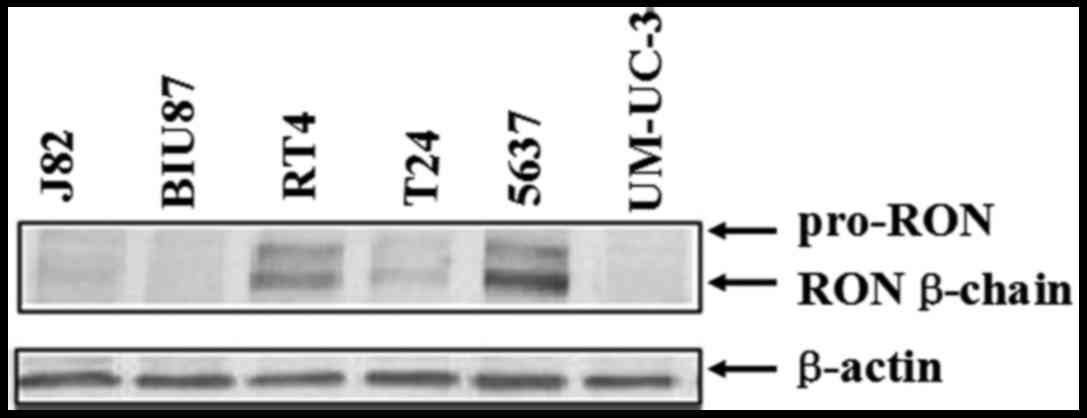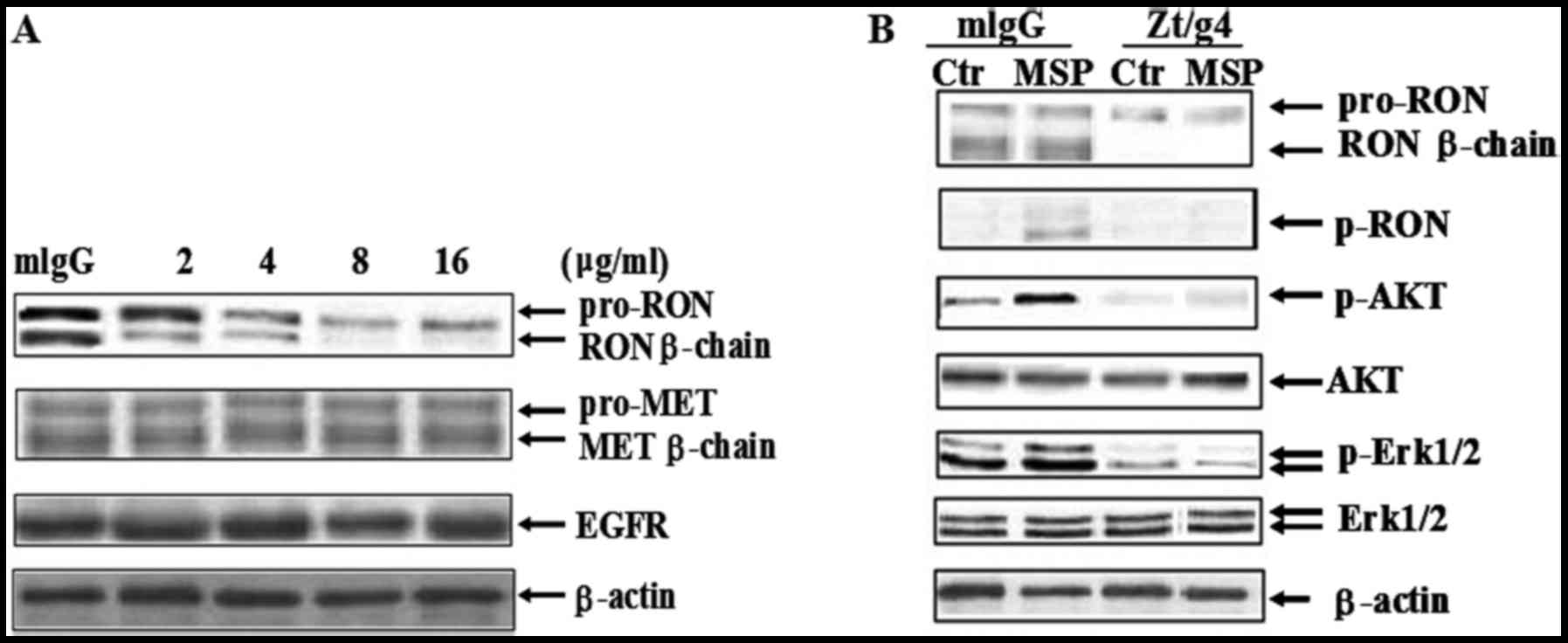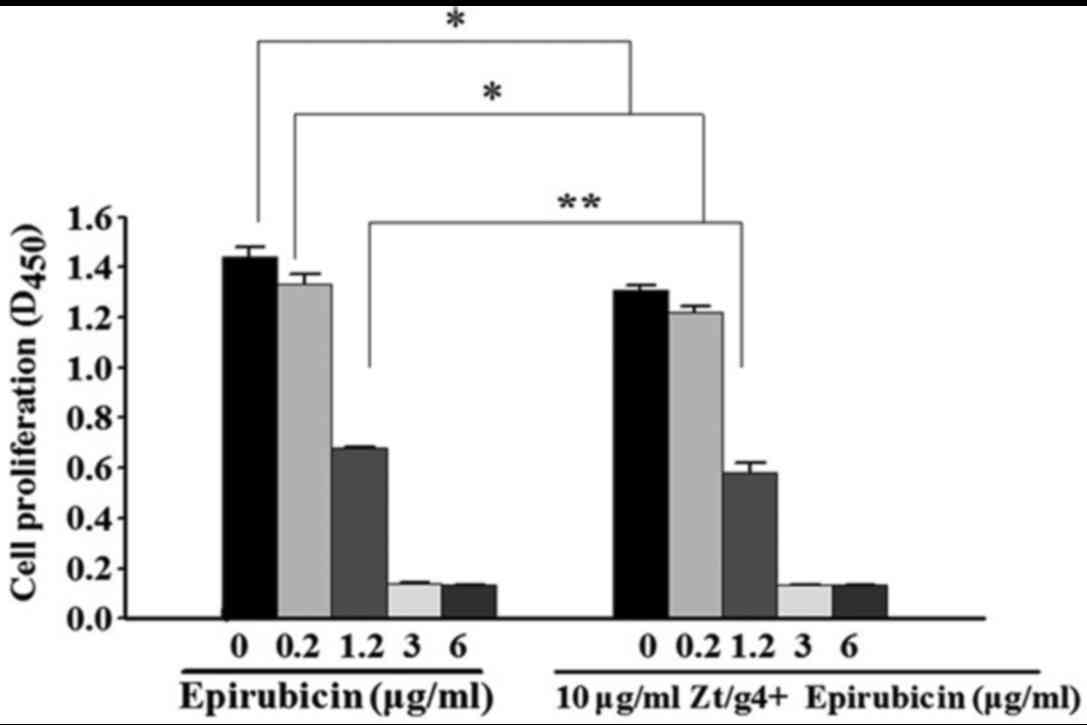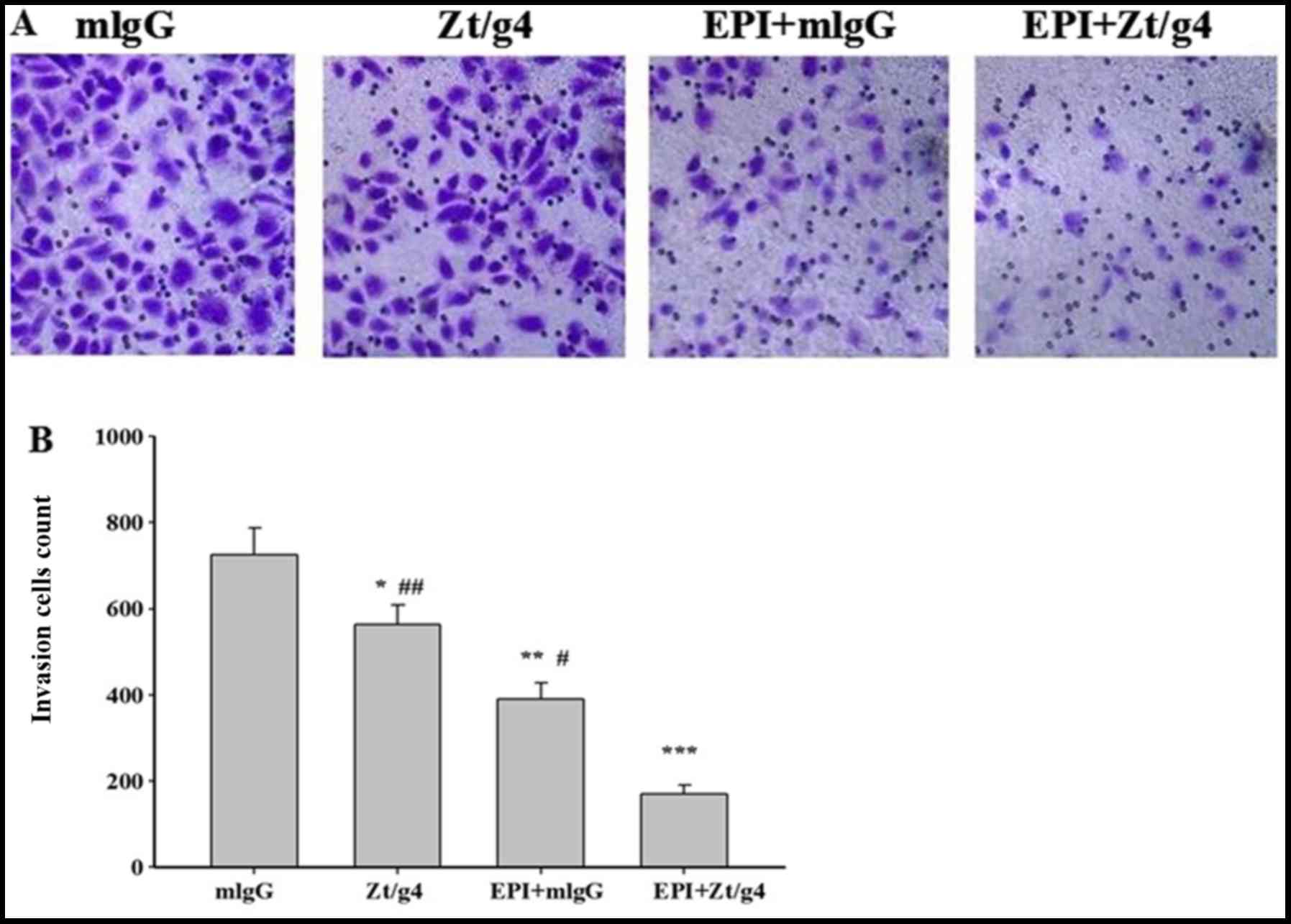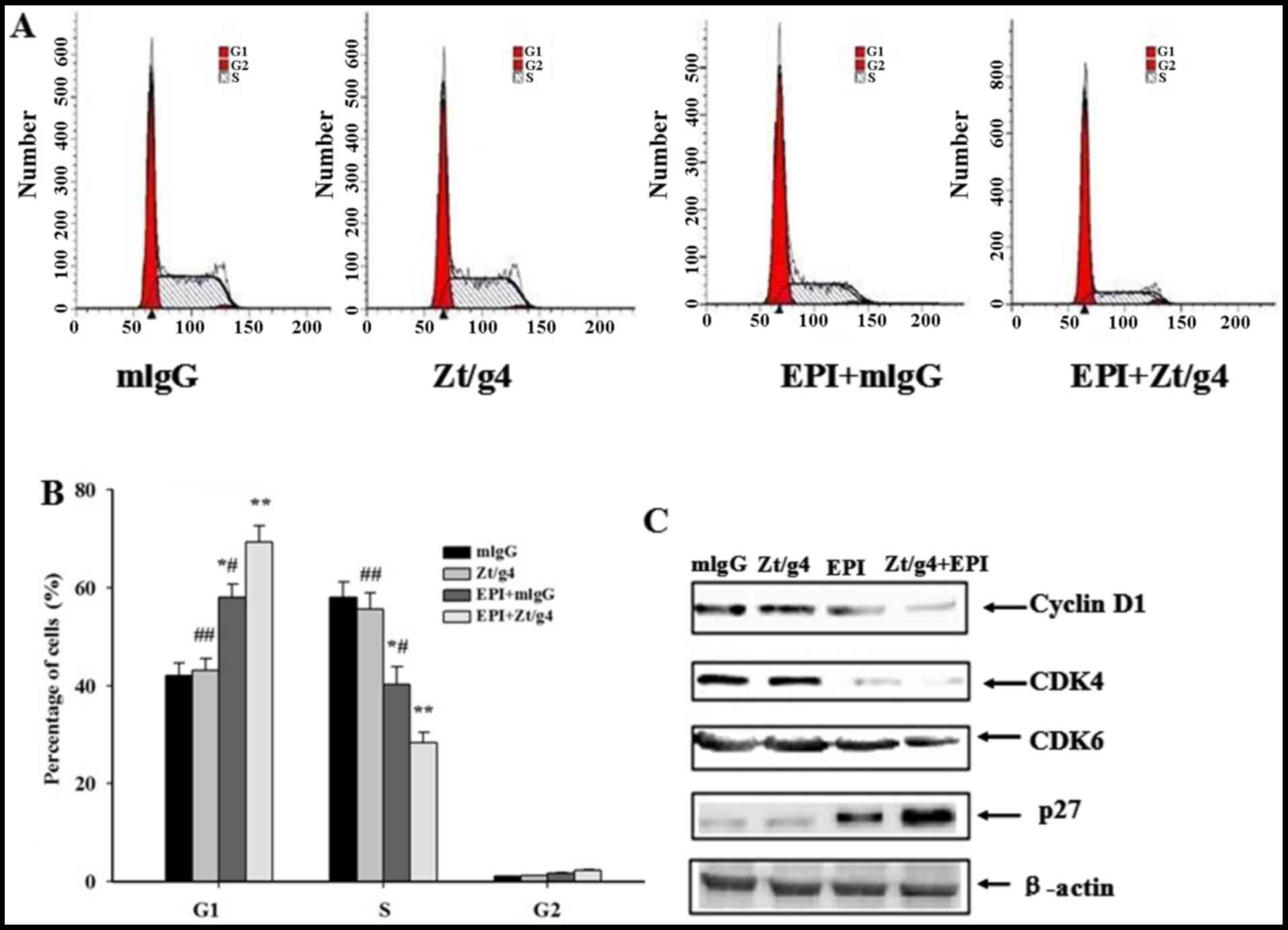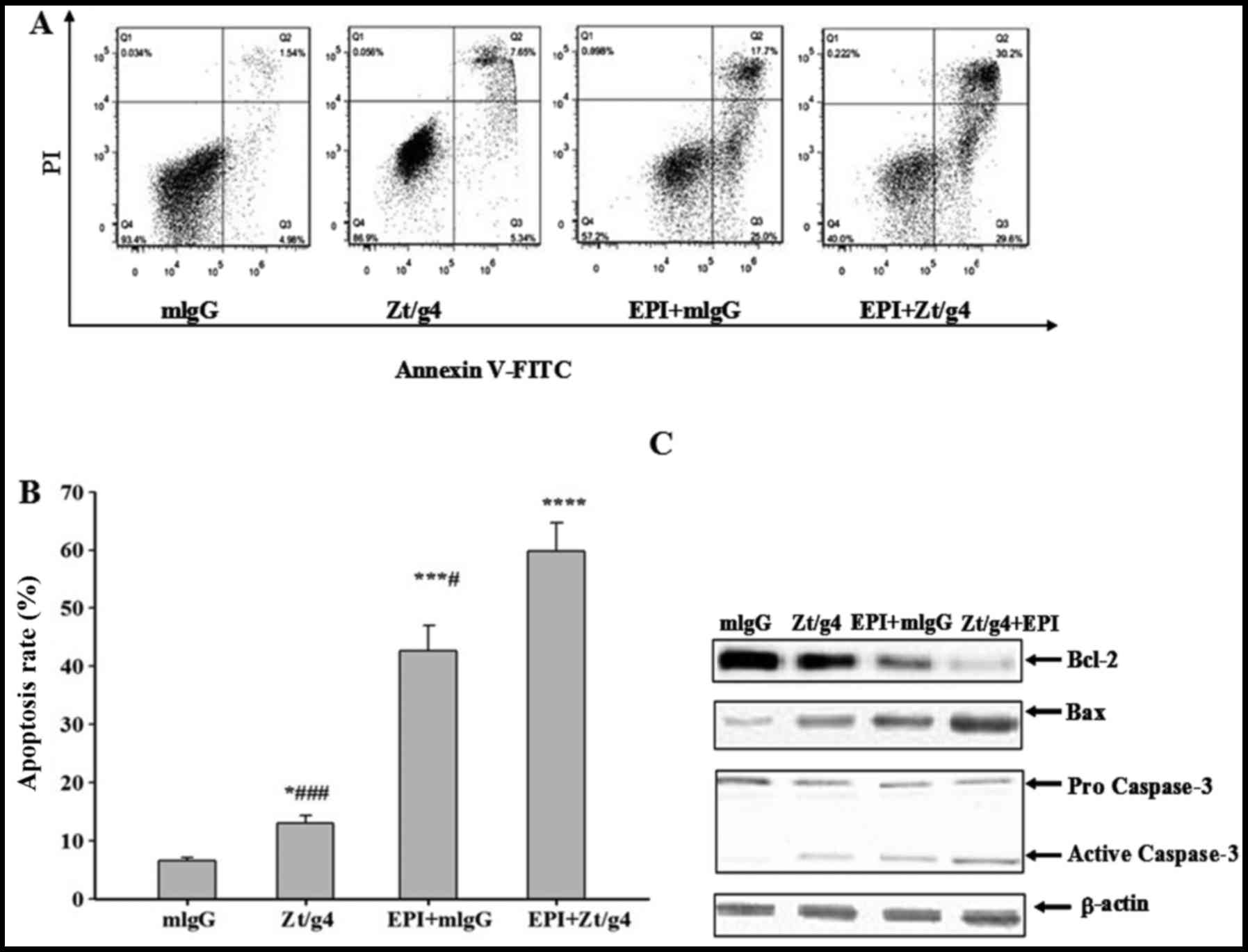Monoclonal antibody Zt/g4 targeting RON receptor tyrosine kinase enhances chemosensitivity of bladder cancer cells to Epirubicin by promoting G1/S arrest and apoptosis
- Authors:
- Published online on: January 5, 2017 https://doi.org/10.3892/or.2017.5356
- Pages: 721-728
-
Copyright: © Chen et al. This is an open access article distributed under the terms of Creative Commons Attribution License.
Abstract
Introduction
Bladder cancer is a major cause of morbidity and mortality worldwide, and in the United States alone, 76,960 newly diagnosed cases and 16,390 deaths are estimated in 2015 (1). Approximately 70% of patients with bladder cancer are non-muscle-invasive (NMIBC) at diagnosis (2). NMIBC is characterized by significant rates of recurrence and progression. The range of recurrence is 50–80%, and progression 10–45%, depending on disease risks (based upon grade, stage, and tumor size) (3). Transurethral resection of bladder tumor (TURBT) combined with intravesical chemotherapy is the primary method for treatment of NMIBC (4). The aim of intravesical chemotherapy is to decrease the possibility of tumor recurrence and progression. At present, Epirubicin (EPI), a derivative of doxorubicin, is one of the most used intravesical chemotherapy agents to treat NMIBC (5). Comparing with TURBT alone, EPI instillation after TURBT decreased nearly half of recurrence and progression of NMIBC (6). Although intravesical EPI chemotherapy has improved the clinical outcome of patients with NMIBC, efforts to potentiate drug action and enhance chemosensitivity should be investigated for further improvement of patient outcomes (7).
Recepteur d'origine Nantais (RON) belongs to the MET proto-oncogene family (8). The expression of RON is highly altered in many primary cancer samples including colon, breast and bladder cancer, and has prognostic value in predicting patient survival and clinical outcome (9–11). Aberrant RON activation, featured by overexpression of RON protein (12–14), isoform generation (15–17), and persistent activation of downstream signaling pathways (18), has been found in various types of cancers. Those aberrations contribute to tumorigenic phenotype, malignant progression and chemoresistance (9,11,19). Due to the importance of RON in cancer pathogenesis, targeting RON signal pathway has therapeutic potential. Currently, various approaches including therapeutic monoclonal antibodies (mAb), siRNA and small molecule inhibitors (SMI) have been evaluated to inhibit RON signaling (20–22). Results from these studies demonstrate that inhibition of RON signaling contributes to reduced cell growth, diminished cell invasiveness, and impaired tumor metastasis. Combining RON signaling inhibition and chemotherapy agents were also under investigation in treating with various cancers. In colon cancer, 5-Fu in combination with RON specific mAb Zt/f2 has been showed to markedly improve treatment effects (20), suggesting that inhibiting RON pathway may enhance chemosensitivity of chemotherapy drugs.
In bladder cancers, RON is overexpressed in more than 35% of samples (11,14). RON expression has been documented in RT4, TCCSUP, UB09 and other bladder cancer cell lines (11). Overexpression of RON was associated with poor clinical outcome (11,23). Furthermore, MSP, the only known ligand of RON, was also detected in human urine samples (11). These findings suggested that RON plays a role in bladder cancer tumorigenesis and invasion. Evidence has indicated that RON-specific mAbs such as Zt/g4 and Zt/f2 rapidly induce RON internalization by cancer cells, which diminish RON signal transduction and enhance cytotoxic drug delivery and sensitivity (20,24–27). Thus, RON-specific mAbs are potentially effective approach to RON signal inhibition and enhancement of chemosensitivity.
In the present study, we selected a mouse mAb Zt/g4 highly specific to the RON extracellular domain to induce RON internalization and subsequent RON signal pathway inhibition. EPI was used as chemotherapeutical agent to determine the effects of RON on chemosensitivity in bladder cancer cells. This study provides new strategy to reduce NMIBC recurrence and progression.
Materials and methods
Cell lines and cell culture
The human 5637, T24, RT4, J82, UMUC and BIU87 bladder cancer cell lines were purchased from the Shanghai Institute of Cell Biology, Chinese Academy of Sciences (Shanghai, China). The cells were cultured at 37°C in a humidified atmosphere of 5% CO2 in RPMI-1640 medium supplemented with 10% (v/v) fetal bovine serum (FBS), 2 mM L-glutamine and 100 U/ml penicillin. The medium was replaced every 3 days.
Main reagents
EPI was purchased from the Hisun Pharmaceutical Co., Ltd. (Zhejiang, China). Cell Counting Kit-8 (CCK-8) was purchased from Dojindo Molecular Technologies (Rockville, MD, USA). Mouse mAb Zt/g4 specific to RON sema domain and rabbit antibody (R5029, specific to the RON C-terminal peptide) were kindly supplied by Professor Yao (Laboratory of Cancer Biology and Therapeutics, First Affiliated Hospital, Zhejiang University School of Medicine). Rabbit anti-Bcl-2, anti-Bax, anti-Erk1/2, anti-AKT, anti-caspase-3, anti-cyclin D1, anti-CDK4, anti-CDK6 and anti-p27 antibodies were from Cellular Signaling Technology (Danvers, MA, USA). FBS, RPMI-1640, L-glutamine and penicillin were purchased from Life Technologies Inc. (Carlsbad, CA, USA).
Western blotting
Western blot analysis was performed to measure the expression levels of various proteins in cells. Each sample equivalent of 100 µg total proteins were electrophoresed in 8% SDS-PAGE and blotted on a nitrocellulose membrane (Millipore Inc., Billerica, MA, USA). Blots were blocked at room temperature for 2 h in 1X Tris-buffered saline (TBS) buffer, and then incubated with primary antibodies specific to Ron, Bcl-2, Bax and β-actin overnight at 4°C, respectively. After three washes for 3×10 min in TBST, the membrane was incubated with horseradish peroxidase (HRP)-conjugated anti-mouse or anti-rabbit immunoglobulin G at room temperature for 1 h. Immunoreactive proteins were visualized by enhanced chemiluminescent reagents (Thermo Scientific, Rockford, IL, USA). The optical density was quantified by VersaDoc Imaging system (Bio-Rad, Hercules, CA, USA).
Transwell invasion assay
The cells were seeded at a concentration ratio of 5×104 cells/chamber in serum-free RPMI-1640 and placed on the 8 µm pore-size upper chamber (Corning Incorporated, Corning, NY, USA). The lower chambers contained RPMI-1640 culture media with 10% FBS. After 24 h of incubation, non-invading cells on the top chamber were removed by using a cotton swab, and cells that penetrated to the lower surface were fixed with 800 µl methanol for 30 min, stained with 0.5% crystal violet solution for 2 h, washed with 1X PBS and counted under a microscope. Six fields were randomly selected from each sample, with triplicates.
Cell viability assay
Sensitivity of cells to EPI was assayed with the CCK-8 kit. Briefly, cells were seeded in 96-well plates with a density of 1×104/well and incubated for 24 h at 37°C and then treated with EPI (0.2, 1. 2, 3 and 6 µg/ml), Zt/g4 (8 µg/ml) combined with EPI for 48 h. The proportion of live cells of the two groups was analyzed by CCK-8 kit according to the manufacturer's instructions. Finally, the absorbance (OD) value of each well was measured by a microplate reader at the wavelength of 450 nm. The experiment was carried out in triplicate. Dose-dependent response curve was plotted and the half maximal inhibitory concentration (IC50) was determined by fitting the concentration response curves with the sigmaplot software.
Cell cycle analysis
Cell cycle status was detected by flow cytometry and analyzed by Flowjo software. Briefly, after exposed to Zt/g4, EPI or both for 24 h, cells (2×105-106) were harvested, fixed with 75% ethanol overnight at −20°C. The fixed cells were incubated in darkness at 37°C with 1 mg/ml RNase A (Sigma-Aldrich, St. Louis, MO, USA) for 30 min and with 50 µg/ml propidium iodide (PI) (Sigma-Aldrich) for 30 min. The cells were analyzed by flow cytometry (FACScan, Becton-Dickinson, Franklin Lakes, NJ, USA).
Apoptosis analysis
After Zt/g4, EPI or both for 48 h, the cells were collected and washed twice with cold PBS, followed by resuspension in binding buffer at the density of 1×106 cells/ml. 100 µl (1×105 cells) of the solution was removed and stained with 5 µl Annexin V-FITC and PI (BD Biosciences) for 15 min in the dark at room temperature. Then a total of 400 dilution buffer was added to each tube and cell apoptosis was analysed by flow cytometry (FACScan, Becton-Dickinson). The percentage of apoptotic cells with Annexin V+/PI+ was evaluated. Each group was measured three times.
Statistical analysis
Statistical analyses were performed using SPSS software (version 18; SPSS Inc., Chicago, IL, USA). Data are presented as the means ± standard deviation (SD). Statistical significance between two groups was evaluated by Student's t-test. Differences between multiple groups were performed by one-way analysis of variance. A difference was considered significant at P<0.05.
Results
Expression of RON receptors in bladder cancer cell lines
The expression of RON was detected by western blotting in seven bladder cancer cell lines (Fig. 1). In this panel, 5637, T24 and RT4 cell lines had a high level of RON expression, while the expression levels of RON in other three cancer cell lines were barely found. As the 5637 cells expressed a relatively higher level of RON than those in T24 and RT4 cells, we chose 5637 cells for future studies.
Zt/g4 induces reduction of RON expression and signal inhibition
Western blot analysis confirmed that Zt/g4 treatment for 24 h caused diminished RON expression in a dose-dependent manner in 5637 cells (Fig. 2A). When used with 2 µg/ml of Zt/g4, Zt/g4-induced reduction of RON β-chain expression was significantly identified. However, the concentration of Zt/g4 increased up to 8 µg/ml, but did not further cause RON reduction. Thus, the maximal effect induced by Zt/g4 was at the range of 8 µg/ml. We chose this concentration as the standard for further experiments. Cross-talk between RON and MET or EGFR has been found in various cancer cells (28,29). We verified whether Zt/g4-induced RON reduction affected MET or EGFR expression in 5637 cells. Result showed that there were no significant differences in the total level of MET and EGFR expression in 5637 cells after Zt/g4 treatment. Taken together, these results demonstrated that Zt/g4-induced RON reduction was specific to RON and had no effect on MET or EGFR.
As MSP was detected in human urine samples (11), MSP induced RON activation and signaling transduction may be a key event in bladder tumorigenesis and invasion. To test whether Zt/g4 blocks MSP induced RON activation and downstream signaling transduction, 5 nM MSP was added to induce RON activation with or without 8 µg/ml Zt/g4 treatment (Fig. 2B). Result showed that after Zt/g4 treatment for 48 h, MSP induced RON activation was completely inhibited. Phosphorylation of downstream signal molecules such as Erk1/2 and AKT were also interrupted (Fig. 2B).
Zt/g4 enhances the chemosensitivity of EPI on 5637 cells
To determine whether inhibition of RON signaling by Zt/g4 enhance chemosensitivity of EPI in 5637 cells, a CCK-8 assay was carried out to measure the proliferation status of the cells. 5637 cells were treated with EPI or Zt/g4 combined with EPI at different concentrations. After 48 h, the cell viability was reduced with increasing concentrations of EPI (Fig. 3). The levels of cytotoxicity were indicated as the concentration that inhibits the response by 50% IC50 value. The IC50 values in Zt/g4 combined with EPI and EPI were (0.9±0.13, 1.2±0.09), respectively. Data showed that RON inhibition by Zt/g4 was able to enhance the sensitivity of 5637 cells to EPI at the concentrations of 0.2 and 1.2 µg/ml (P<0.05). Since the IC50 value in EPI treated 5637 cells was (1.2±0.09 µg/ml), the concentration of EPI intervention in subsequent experiments was determined as 1.2 µg/ml.
Zt/g4 combining with EPI markedly decreases 5637 cell invasion
Tumor invasion and progression is a common event in NMIBC even after TURBT and intravesical chemotherapy. To study whether combining Zt/g4 and EPI affected cellular invasion, we further carried out Transwell assay on the 5637 cells. The cells were treated with 8 µg/ml Zt/g4 alone, 1.2 µg/ml EPI alone, EPI combined with Zt/g4, or mouse IgG in transmembrane chambers for 24 h. The results showed that the invasive cell count of Zt/g4 in combination with EPI was significantly lower than that of Zt/g4 or EPI alone (170±21 vs. 564±49 or 390±37 individually) (Fig. 4A and B), and the cell invasive capacity of the Zt/g4 treatment group (564±49) was significantly lower than the mlgG group (726±62) (mlgG was used as the control).
Cell cycle arrested at G1/S phase in 5637 cells by Zt/g4 combining with EPI treatment
EPI can often inhibit cell proliferation through induction of cell cycle arrest. To determine whether Zt/g4 intracellular delivery of EPI resulted in cell cycle changes, we incubated cells with Zt/g4, EPI or both for 24 h and then examined the DNA content using propidium iodide (PI) staining. The proportions of cells treated with Zt/g4 in each phase of the cell cycle showed no significant difference comparing with those of control group. The changes in cell-cycle profile were observed after addition of EPI combined with Zt/g4, featuring a significant reduction in S phase, an increase in G1 phase, compared to the EPI treatment alone (P<0.05) (Fig. 5A and B). These changes were present in all three 5637 cell lines tested. Moreover, we checked several key factors including cyclin D1, CDK4, CDK6 and p27 regulating the G1/S cell cycle transition. The expression of cyclin D1, CDK4, CDK6 and p27was not changed by Zt/g4 treatment in 5637 cells. However, cotreatment of cells with EPI and Zt/g4 increased the expression of p27 while downregulated cyclin D1, CDK4 and CDK6 comparing with Zt/g4 or EPI treatment alone (Fig. 5C). These results suggested that the G1/S cell cycle arrest induced by Zt/g4 combined with EPI was related with upregulation of the cell cycle inhibitory proteins and downregulation of the cyclin-dependent protein kinases (CDKs) and cyclins.
Zt/g4 combining with EPI treatment promotes apoptosis in 5637 cells
Flow cytometry (FACS) was used to further investigate whether Zt/g4, EPI or both exerted anticancer effect on 5637 cells through inducing apoptosis. We exposed 5637 cells to Zt/g4, EPI or both as previously mentioned, and then stained them with Annexin V-PE and PI to measure apoptosis rates after incubation for 48 h. FACS analysis showed that total apoptosis rates of EPI combined with Zt/g4 were significantly increased when comparing with EPI or Zt/g4 treatment alone (Fig. 6A and B). This result indicated that Zt/g4 was able to promote the EPI-induced apoptosis in 5637 cells. To further unveil the mechanisms by which Zt/g4 enhanced EPI-induced apoptosis in 5637 cells, the cells were treated with Zt/g4, EPI or both for 48 h and subjected to western blot analysis. The bcl-2 protein expression in EPI plus Zt/g4 cells was markedly lower while Bax and active caspase-3 protein expression levels were higher than those in the Zt/g4 or EPI treatment cells (Fig. 6C). This result suggested that downregulation of RON by Zt/g4 promoted EPI induced apoptosis of 5637 cells through mitochondria-mediated apoptotic pathway.
Discussion
Bladder cancer can be divided into three categories based on its prognosis and management. The first category consists of non-muscle-invasive tumors. The second category consists of muscle invasive bladder cancer (MIBC). The third group is metastasis bladder cancer. Therapeutic aim is different to each of these categories (30). To NMIBC, the main concern is to reduce recurrences and preventing progression to a more advanced stage. TURBT followed by chemotherapy agents and immunotherapy agents are now clinically used to achieve this goal (31). However, even treated with these current approaches, half of NIMBC will recur and progress. More strategies should be investigated to further decrease the rate of NIMBC recurrence and progression.
We and others have found that RON plays an important role in the pathogenesis of bladder cancer (11,14). Although RON is recently reported to associate with the chemosensitivity in human malignancies such as breast cancer and pancreatic cancer (19,32), its role in chemotherapy of bladder cancer remains largely unknown. In this study, our results showed that Ron signaling inhibition by Zt/g4 could remarkably enhance the chemosensitivity of epirubicin (EPI) in human 5637 cells and decrease cell invasion. Possible mechanisms include promotion of cell cycle arrest and induction of Bcl-2 dependent apoptosis.
Zt/g4 has unique binding specificity to the RON extracellular domains. Recent studies have shown that Zt/g4 is highly effective in downregulation of RON expression by colon, breast and pancreatic cancer cells (26). The binding of Zt/g4 to the epitopes either on sema or IPT domains is sufficient to cause RON reduction due to RON internalization and degradation by proteasome (33). In this study, we found the effect of Zt/g4 is concentration-dependent. Significant reduction of RON was seen when using 2 µg per ml of Zt/g4 and the maximal effect was at the range of 8 µg per ml. However, further increase of Zt/g4 up to 16 µg per ml did not show additional effect (Fig. 2A). In a recent study, Li reported that the maximal rate of Zt/g4 was 10 µg per ml in colon SW620 cells (26). The maximal effect is related to the amounts of Zt/g4 that bind to RON extracellular domain. Cross-talk between RON and MET or EGFR exist on the cell membrane surface, and specifically blocking RON is under intensive investigation (28,29). In the present study, the effect of Zt/g4 was only specific to RON. It had no effect on the structurally-related MET or unrelated EGFR in Fig. 2B. Moreover, after persistent Zt/g4 treatment, MSP induced RON activation was completely inhibited also the downstream pMAPK and pAkt activation was inhibited in 5637 cells.
Cancer cell unlimited growth and invasion are the most fatal features of malignant tumors, accounting for >90% of tumor-related mortality (34). Overexpression of RON contributes to increased cell growth and invasion (35,36). The results of this study showed that Zt/g4 or EPI alone could moderately inhibit cell proliferation and invasion in 5637 cells, but when Zt/g4 was used in combination with EPI it showed significant inhibition of cell proliferation (Fig. 3)and invasion (Fig. 4). Without Zt/g4, IC50 of EPI to 5637 cells was 1.2±0.09 µg/ml per 105 cells, after combining with Zt/g4, IC50 of EPI to 5637 cells was markedly decreased to 0.9±0.13 µg/ml per 105 cells. Therefore, Zt/g4 was efficient in enhancing chemosensitivity of EPI.
It was documented recently that Zt/g4 intracellular delivery of maytansinoid could result in cell cycle changes, suggesting that cell cycle arrest might contribute to enhancement of chemosensitivity by Zt/g4 (37). Therefore, we analyzed the cell cycle distribution of EPI-treated 5637 cells. EPI alone moderately affected cell cycle distribution in the cells, but when it was combined with Zt/g4, an obvious G1/S arrest was found (Fig. 5). Thus, Zt/g4-targeted delivery of EPI affects the cell cycle in 5637 cells. The cyclin-dependent kinases (CDKs) and cyclins play a crucial role in the regulation of cell cycle progression (38,39). The G1 cyclin-CDK complex cyclin D-CDK4/6 is required for S phase entry (40). CDK inhibitors (CKIs) such as p21CIP1/WAF1 and p27KIP1 bind to cyclin-CDK complexes and render them inactive, which inhibit cell cycle progression (41). In our study, we found that cotreatment of Zt/g4 and EPI leads to G1/S arrest into 5637 cells (Fig. 5A and B), which is accompanied by the downregulation of cyclin D1, CDK4 and CDK6, whereas it increased the level of P27 (Fig. 5C).
Apoptosis is a defensive mechanism of the body against the progression and development of tumor. Several studies have suggested that RON is associated with apoptosis in various cancer cells (42,43). However, the impact of RON on apoptosis in human bladder cancer is not reported. Thus, investigating the effect of Zt/g4 on EPI-induced cell apoptosis in 5637 cells is highly desirable. Our experiments showed that EPI-treated 5637 cells exhibited an increase in Annexin V(+)/PI(−) staining, and combined with Zt/g4 treatment strengthened this effect, indicating that Zt/g4 promoted EPI induced apoptosis (Fig. 6B). The mitochondrial apoptotic pathway is mainly mediated by proteins of the Bcl-2 family such as Bcl-2 and Bax (44). Bcl-2 is an anti-apoptotic protein, which negatively regulates the activation of caspase-3 that acted as an effector of mammalian cell death pathways (45). Bax is a proapoptotic protein, and the activation of Bax can increase the mitochondrial permeability and the release of pro-apoptotic molecules such as cytochrome-c. Releasing of cytochrome c can active caspase-3 and leads finally to apoptosis (46). In this study, combining EPI and Zt/g4 significantly decreased the protein expression levels of Bcl-2 while increased the protein expression levels of Bax and cleaved caspase-3, suggesting Zt/g4 promoted EPI-induced apoptosis via the mitochondrial-dependent pathway.
In summary, the results of this study demonstrated that inhibition of RON signaling pathway by Zt/g4 markedly improved chemosensitivity of EPI in bladder cancer cells. Both cell proliferation and invasion were effectively inhibited by combining Zt/g4 and EPI treatment. Possible mechanisms underlying this combination include induction of cell cycle arrested at G1/S and promotion of mitochondrial pathway of apoptosis. These data provide new strategies to prevent recurrence and progression, which may further improve clinical outcomes of current approaches in treatment with NMIBC.
Acknowledgements
This study was supported by the National Natural Science Foundation of China (grant no. 81272828 to Q.M., and no. 31501113 to R.Y.), Zhejiang Provincial Foundation for Medical and Health Sciences (grant no. 2016KYB263 and 2014KYB355 to Q.M.), and Ningbo Natural Science Foundation (grant no. 2015A610224 to J.-F.C. and no. 2015A610177 to R.Y.).
References
|
Siegel RL, Miller KD and Jemal A: Cancer statistics, 2016. CA Cancer J Clin. 66:7–30. 2016. View Article : Google Scholar : PubMed/NCBI | |
|
Parekh DJ, Bochner BH and Dalbagni G: Superficial and muscle-invasive bladder cancer: Principles of management for outcomes assessments. J Clin Oncol. 24:5519–5527. 2006. View Article : Google Scholar : PubMed/NCBI | |
|
Porten SP, Leapman MS and Greene KL: Intravesical chemotherapy in non-muscle-invasive bladder cancer. Indian J Urol. 31:297–303. 2015. View Article : Google Scholar : PubMed/NCBI | |
|
Herr HW, Dotan Z, Donat SM and Bajorin DF: Defining optimal therapy for muscle invasive bladder cancer. J Urol. 177:437–443. 2007. View Article : Google Scholar : PubMed/NCBI | |
|
Babjuk M, Oosterlinck W, Sylvester R, Kaasinen E, Böhle A, Palou-Redorta J and Rouprêt M: European Association of Urology (EAU): EAU guidelines on non-muscle-invasive urothelial carcinoma of the bladder, the 2011 update. Eur Urol. 59:997–1008. 2011. View Article : Google Scholar : PubMed/NCBI | |
|
Oosterlinck W, Kurth KH, Schröder F, Bultinck J, Hammond B and Sylvester R: A prospective European Organization for Research and Treatment of Cancer Genitourinary Group randomized trial comparing transurethral resection followed by a single intravesical instillation of epirubicin or water in single stage Ta, T1 papillary carcinoma of the bladder. J Urol. 149:749–752. 1993.PubMed/NCBI | |
|
Yu R, Yu BX, Chen JF, Lv XY, Yan ZJ, Cheng Y and Ma Q: Anti-tumor effects of Atractylenolide I on bladder cancer cells. J Exp Clin Cancer Res. 35:402016. View Article : Google Scholar : PubMed/NCBI | |
|
Ronsin C, Muscatelli F, Mattei MG and Breathnach R: A novel putative receptor protein tyrosine kinase of the met family. Oncogene. 8:1195–1202. 1993.PubMed/NCBI | |
|
Park YL, Lee GH, Kim KY, Myung E, Kim JS, Myung DS, Park KJ, Cho SB, Lee WS, Jung YD, et al: Expression of RON in colorectal cancer and its relationships with tumor cell behavior and prognosis. Tumori. 98:652–662. 2012.PubMed/NCBI | |
|
Feres KJ, Ischenko I and Hayman MJ: The RON receptor tyrosine kinase promotes MSP-independent cell spreading and survival in breast epithelial cells. Oncogene. 28:279–288. 2009. View Article : Google Scholar : PubMed/NCBI | |
|
Cheng HL, Liu HS, Lin YJ, Chen HH, Hsu PY, Chang TY, Ho CL, Tzai TS and Chow NH: Co-expression of RON and MET is a prognostic indicator for patients with transitional-cell carcinoma of the bladder. Br J Cancer. 92:1906–1914. 2005. View Article : Google Scholar : PubMed/NCBI | |
|
Catenacci DV, Cervantes G, Yala S, Nelson EA, El-Hashani E, Kanteti R, El Dinali M, Hasina R, Brägelmann J, Seiwert T, et al: RON (MST1R) is a novel prognostic marker and therapeutic target for gastroesophageal adenocarcinoma. Cancer Biol Ther. 12:9–46. 2011. View Article : Google Scholar : PubMed/NCBI | |
|
Ren X, Daa T, Yada N, Kashima K, Fujitomi Y and Yokoyama S: Expression and mutational status of RON in neoplastic lesions of the breast: Analysis of MSP/RON signaling in ductal carcinoma in situ and invasive ductal carcinoma. APMIS. 120:358–367. 2012. View Article : Google Scholar : PubMed/NCBI | |
|
Wang MH, Lee W, Luo YL, Weis MT and Yao HP: Altered expression of the RON receptor tyrosine kinase in various epithelial cancers and its contribution to tumourigenic phenotypes in thyroid cancer cells. J Pathol. 213:402–411. 2007. View Article : Google Scholar : PubMed/NCBI | |
|
Wang MH, Kurtz AL and Chen Y: Identification of a novel splicing product of the RON receptor tyrosine kinase in human colorectal carcinoma cells. Carcinogenesis. 21:1507–1512. 2000. View Article : Google Scholar : PubMed/NCBI | |
|
Eckerich C, Schulte A, Martens T, Zapf S, Westphal M and Lamszus K: RON receptor tyrosine kinase in human gliomas: Expression, function, and identification of a novel soluble splice variant. J Neurochem. 109:969–980. 2009. View Article : Google Scholar : PubMed/NCBI | |
|
Ma Q, Zhang K, Guin S, Zhou YQ and Wang MH: Deletion or insertion in the first immunoglobulin-plexin-transcription (IPT) domain differentially regulates expression and tumorigenic activities of RON receptor Tyrosine Kinase. Mol Cancer. 9:3072010. View Article : Google Scholar : PubMed/NCBI | |
|
Yao HP, Zhou YQ, Zhang R and Wang MH: MSP-RON signalling in cancer: Pathogenesis and therapeutic potential. Nat Rev Cancer. 13:466–481. 2013. View Article : Google Scholar : PubMed/NCBI | |
|
Prislei S, Mariani M, Raspaglio G, Mozzetti S, Filippetti F, Ferrandina G, Scambia G and Ferlini C: RON and cisplatin resistance in ovarian cancer cell lines. Oncol Res. 19:13–22. 2010. View Article : Google Scholar : PubMed/NCBI | |
|
Yao HP, Zhou YQ, Ma Q, Guin S, Padhye SS, Zhang RW and Wang MH: The monoclonal antibody Zt/f2 targeting RON receptor tyrosine kinase as potential therapeutics against tumor growth-mediated by colon cancer cells. Mol Cancer. 10:82–93. 2011. View Article : Google Scholar : PubMed/NCBI | |
|
Xu XM, Wang D, Shen Q, Chen YQ and Wang MH: RNA-mediated gene silencing of the RON receptor tyrosine kinase alters oncogenic phenotypes of human colorectal carcinoma cells. Oncogene. 23:8464–8474. 2004. View Article : Google Scholar : PubMed/NCBI | |
|
Yao HP, Zhuang CM, Zhou YQ, Zeng JY, Zhang RW and Wang MH: Oncogenic variant RON160 expression in breast cancer and its potential as a therapeutic target by small molecule tyrosine kinase inhibitor. Curr Cancer Drug Targets. 13:686–697. 2013. View Article : Google Scholar : PubMed/NCBI | |
|
Hsu PY, Liu HS, Cheng HL, Tzai TS, Guo HR, Ho CL and Chow NH: Collaboration of RON and epidermal growth factor receptor in human bladder carcinogenesis. J Urol. 176:2262–2267. 2006. View Article : Google Scholar : PubMed/NCBI | |
|
Guin S, Yao HP and Wang MH: RON receptor tyrosine kinase as a target for delivery of chemodrugs by antibody directed pathway for cancer cell cytotoxicity. Mol Pharm. 7:386–397. 2010. View Article : Google Scholar : PubMed/NCBI | |
|
Guin S, Ma Q, Padhye S, Zhou YQ, Yao HP and Wang MH: Targeting acute hypoxic cancer cells by doxorubicin-immunoliposomes directed by monoclonal antibodies specific to RON receptor tyrosine kinase. Cancer Chemother Pharmacol. 67:1073–1083. 2011. View Article : Google Scholar : PubMed/NCBI | |
|
Li Z, Yao H, Guin S, Padhye SS, Zhou YQ and Wang MH: Monoclonal antibody (mAb)-induced down-regulation of RON receptor tyrosine kinase diminishes tumorigenic activities of colon cancer cells. Int J Oncol. 37:473–482. 2010.PubMed/NCBI | |
|
Padhye SS, Guin S, Yao HP, Zhou YQ, Zhang R and Wang MH: Sustained expression of the RON receptor tyrosine kinase by pancreatic cancer stem cells as a potential targeting moiety for antibody-directed chemotherapeutics. Mol Pharm. 8:2310–2319. 2011. View Article : Google Scholar : PubMed/NCBI | |
|
Follenzi A, Bakovic S, Gual P, Stella MC, Longati P and Comoglio PM: Cross-talk between the proto-oncogenes Met and Ron. Oncogene. 19:3041–3049. 2000. View Article : Google Scholar : PubMed/NCBI | |
|
Peace BE, Hill KJ, Degen SJ and Waltz SE: Cross-talk between the receptor tyrosine kinases Ron and epidermal growth factor receptor. Exp Cell Res. 289:317–325. 2003. View Article : Google Scholar : PubMed/NCBI | |
|
Clark PE, Agarwal N, Biagioli MC, Eisenberger MA, Greenberg RE, Herr HW, Inman BA, Kuban DA, Kuzel TM, Lele SM, et al: National Comprehensive Cancer Network (NCCN): Bladder cancer. J Natl Compr Canc Netw. 11:446–475. 2013.PubMed/NCBI | |
|
Babjuk M, Burger M, Zigeuner R, Shariat SF, van Rhijn BW, Compérat E, Sylvester RJ, Kaasinen E, Böhle A, Redorta J Palou, et al: European Association of Urology: EAU guidelines on non-muscle-invasive urothelial carcinoma of the bladder: Update 2013. Eur Urol. 64:639–653. 2013. View Article : Google Scholar : PubMed/NCBI | |
|
Logan-Collins J, Thomas RM, Yu P, Jaquish D, Mose E, French R, Stuart W, McClaine R, Aronow B, Hoffman RM, et al: Silencing of RON receptor signaling promotes apoptosis and gemcitabine sensitivity in pancreatic cancers. Cancer Res. 70:1130–1140. 2010. View Article : Google Scholar : PubMed/NCBI | |
|
Yao HP, Luo YL, Feng L, Cheng LF, Lu Y, Li W and Wang MH: Agonistic monoclonal antibodies potentiate tumorigenic and invasive activities of splicing variant of the RON receptor tyrosine kinase. Cancer Biol Ther. 5:1179–1186. 2006. View Article : Google Scholar : PubMed/NCBI | |
|
Jin X, Zhu Z and Shi Y: Metastasis mechanism and gene/protein expression in gastric cancer with distant organs metastasis. Bull Cancer. 101:E1–E12. 2014.PubMed/NCBI | |
|
Wagh PK, Peace BE and Waltz SE: Met-related receptor tyrosine kinase Ron in tumor growth and metastasis. Adv Cancer Res. 100:1–33. 2008. View Article : Google Scholar : PubMed/NCBI | |
|
Camp ER, Liu W, Fan F, Yang A, Somcio R and Ellis LM: RON, a tyrosine kinase receptor involved in tumor progression and metastasis. Ann Surg Oncol. 12:273–281. 2005. View Article : Google Scholar : PubMed/NCBI | |
|
Feng L, Yao HP, Wang W, Zhou YQ, Zhou J, Zhang R and Wang MH: Efficacy of anti-RON antibody Zt/g4-drug maytansinoid conjugation (Anti-RON ADC) as a novel therapeutics for targeted colorectal cancer therapy. Clin Cancer Res. 20:6045–6058. 2014. View Article : Google Scholar : PubMed/NCBI | |
|
Morgan DO: Cyclin-dependent kinases: Engines, clocks, and microprocessors. Annu Rev Cell Dev Biol. 13:261–291. 1997. View Article : Google Scholar : PubMed/NCBI | |
|
Murray AW and Marks D: Can sequencing shed light on cell cycling? Nature. 409:844–846. 2001. View Article : Google Scholar : PubMed/NCBI | |
|
Connell-Crowley L, Elledge SJ and Harper JW: G1 cyclin-dependent kinases are sufficient to initiate DNA synthesis in quiescent human fibroblasts. Curr Biol. 8:65–68. 1998. View Article : Google Scholar : PubMed/NCBI | |
|
Vermeulen K, Van Bockstaele DR and Berneman ZN: The cell cycle: A review of regulation, deregulation and therapeutic targets in cancer. Cell Prolif. 36:131–149. 2003. View Article : Google Scholar : PubMed/NCBI | |
|
Chung CY, Park YL, Song YA, Myung E, Kim KY, Lee GH, Ki HS, Park KJ, Cho SB, Lee WS, et al: Knockdown of RON inhibits AP-1 activity and induces apoptosis and cell cycle arrest through the modulation of Akt/FoxO signaling in human colorectal cancer cells. Dig Dis Sci. 57:371–380. 2012. View Article : Google Scholar : PubMed/NCBI | |
|
Song YA, Park YL, Kim KY, Myung E, Chung CY, Cho SB, Lee WS, Jung YD, Kweon SS and Joo YE: RON is associated with tumor progression via the inhibition of apoptosis and cell cycle arrest in human gastric cancer. Pathol Int. 62:127–136. 2012. View Article : Google Scholar : PubMed/NCBI | |
|
Brunelle JK and Letai A: Control of mitochondrial apoptosis by the Bcl-2 family. J Cell Sci. 122:437–441. 2009. View Article : Google Scholar : PubMed/NCBI | |
|
Nakashima T, Miura M and Hara M: Tetrocarcin A inhibits mitochondrial functions of Bcl-2 and suppresses its anti-apoptotic activity. Cancer Res. 60:1229–1235. 2000.PubMed/NCBI | |
|
Wong RS: Apoptosis in cancer: From pathogenesis to treatment. J Exp Clin Cancer Res. 30:872011. View Article : Google Scholar : PubMed/NCBI |



